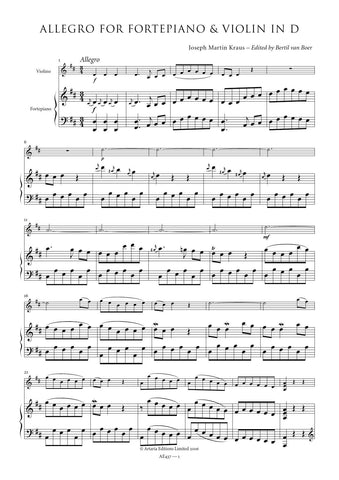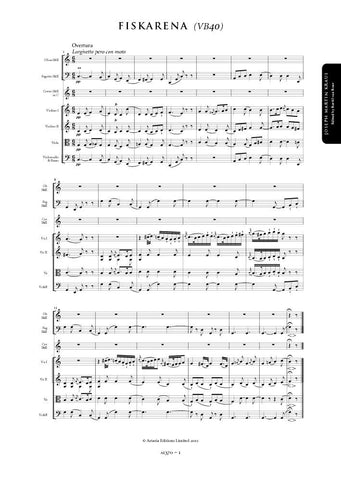Description |
Kraus, Joseph Martin (1756-1792)
|
||||||||||||||||||
Audio sample |
|||||||||||||||||||
Details |
The Pantomime in G (VB 38) is the more expansive of these last two works, consisting of four movements. It was most likely composed for some celebration at the Jesuit Gymnasium and Music Seminar in Mannheim during the years 1769-1772, a period when the composer was beginning to learn his craft from the official teachers such as Pater Alexander Keck, as well as those composers of the famed Mannheim Court Orchestra. From all the evidence, Kraus was an active participant in the varied cultural life of the Palatinate capital, singing roles in various student operettas, performing on the violin, enthusiastically promoting German literature, and showing an aptitude for musical composition. Keck noted with pride that, when he was too busy to complete a "Musik- Spiel" (a sort of student operetta), he gave the nod to his prize pupil Kraus, who completed the work with great skill. Although the circumstances of the two pantomimes that survive from this period are not known, it is likely that they represent efforts to provide music for the annual pantomime scenes that occur during the Carnival season. The four movements of the work include a rather bombastic march and a brief Adagio interlude in rounded binary form. Any programme for the work, however, has not survived. There exists only one source for both Pantomimes, a score in the Silverstolpe Collection at Uppsala, Sweden in the Universitetsbibliotek (Capsula 24). A note on the cover indicates that the copy, in the hand of a Viennese professional, was done in 1802 at the behest of Fredrik Silverstolpe, Kraus's first biographer. From evidence provided by an extensive correspondence between the Swedish diplomat and Kraus's sister Marianne, who provided either a copy or the autograph parts themselves, these pieces are some of the few from Kraus's early years to have survived. The copy is incomplete, the pantomime lacks a bass line in the final movement and the violas throughout. According to a note penned by Silverstolpe on the last page of the copy, this was not an unusual circumstance with this early music. For this edition, new parts have been added based upon style, harmony, and similar parts in other Kraus works.While they may not reflect the missing parts as Kraus originally wrote them, they nonetheless provide a means whereby these compositions can be performed with minimal intervention. There are very few articulation markings in the work, and where they do exist, they are sporadic and inconsistent. These have been incorporated where there is a clear indication such are reasonable. Slurs, also extremely inconsistent, have been cautiously regularized where there are clear indications in the source of the composer's intent; they have omitted where they occur as singular instances. All appoggiaturas have been linked to their principal note with a slur. The few patently wrong notes, the mistakes clearly of the copyist who may not have been a musician himself, have been tacitly corrected as have inconsistencies in the placement of the few dynamic markings. Ornamentation of the work is extremely sparse; no additional ornaments have been added, although there may be places where trills might be appropriate. Their addition is left to the discretion of the performer. The horn parts in the second movement march are likely in C basso, although a case for alto horns, noted by Heinrich Domminch as "toujours usité en Allemagne [always used in Germany]" in his 1802 treatise on horn playing, can be made on account of Kraus's deliberate avoidance of the appoggiatura a'' in bar 24 in the horn part, which would have been too high. Against this and in favour of the lower horn pitch, however, is the overall high tessitura of the horn parts. Bertil van Boer |
||||||||||||||||||
Performance |
29 May 2013
Conductor: Yuki Kasai
Kammerorchester Basel
Residenz - Wuerzburg - Germany
______________________________ 27 May 2013 Conductor: Yuki Kasai Kammerorchester Basel St. Martinskirche - Basel - Switzerland ______________________________ 24 May 2013 Conductor: Julia Schroeder Kammerorchester Basel Wigmore Hall - London - United Kingdom |
||||||||||||||||||
Score Preview (best viewed in full screen mode) |
|||||||||||||||||||
Loading...
Error














